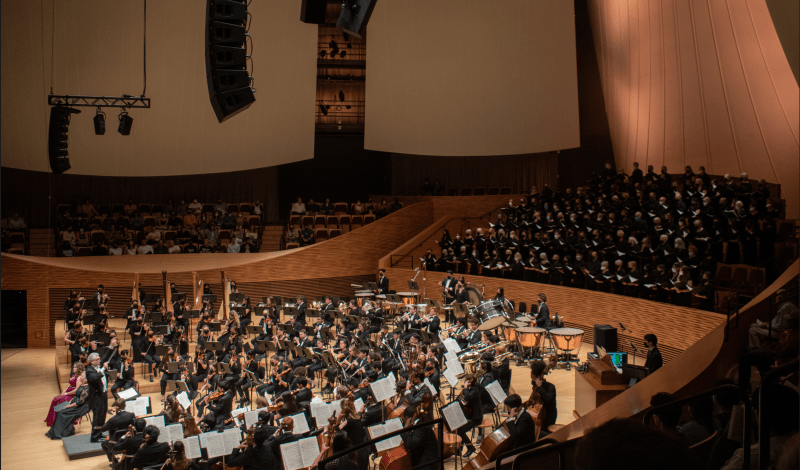Stepping into Bing Concert Hall to immerse myself in Stanford Symphony Orchestra’s (SSO) spring concert on Sunday, I was immediately shocked by the unprecedented size of the audience, filling almost every seat all the way to the top levels of the balcony. Before this audience of excited community members, SSO and Stanford Symphonic Chorus’s performance of Mahler’s Symphony No. 2 and Adolphus Hailstork’s “Epitaph for A Man Who Dreamed” did not disappoint, penetrating into the hearts of the audience with a grand spectacle, featuring the recent 2022 Metropolitan Opera Competition winner Esther Tonea.
SSO opened the concert with American composer Hailstork’s piece, which commemorates the life of Martin Luther King Jr., its title referencing King’s famous “I have a dream” speech delivered at the 1963 March on Washington. As noted by orchestra director Paul Phillips in his opening remarks, the piece is made more significant in light of Saturday’s mass shooting in Buffalo, New York, which resulted in the tragic deaths of 10 Black Americans.
The piece began with an intimate conversation between two cellos and two violas. More instruments soon joined in a whisper, gradually gaining their strength. The cello and viola sections then invited the violins in, and the string section formed a full, hopeful chord at forte volume. The opening section has been widely believed to mimic mourners joining in the singing of a spiritual at King’s funeral. To me, it was also reminiscent of the passing of a baton between sections of a community and mirrored how the Civil Rights Movement started: the incremental actions of individual activists inspired more and more to stand in solidarity with them, eventually culminating in a nation-wide community demanding equality for people of all races and genders.
As the introduction by the string section faded, the flutes voiced a warm melody, depicting King’s life as a serene sunrise. After a series of alternations between bright and mournful motifs, I was surprised that the piece concluded on a solemn E-flat major chord with undertones of menacing brass notes, rather than in a celebratory highlight of King’s accomplishments. While this is consistent with the genre of epitaph being a funeral piece, I wondered if the composer meant for the ending to have further implications on the unfinished legacy of the Civil Rights Movement today, with the resurgence of hate crimes and white supremacist movements stimulated by the coronavirus pandemic.
After the solemn opening of the concert, SSO’s rendition of the famous Mahler Symphony No. 2 ushered the audience into a long journey through death and resurrection. When composing the music, Gustav Mahler provided descriptions of the storyline of the symphony in the tradition of programmatic music. The first movement narrated the funeral of a well-loved man, containing heavy instrumentation led by coarse, war-like bugle calls from the brass section. The movement initiated solemn and deeply unsettling reflections on the meaning of life and death. The serious opening gave way to a light-hearted dance in the second movement, representing the living’s reflections on the happy times of the life of the deceased.
The orchestra then took the audience to the third movement in a playful waltz. The style of this movement, “Scherzo,” implies a joke in Italian, depicting life as a meaningless, ridiculous toil. I was mesmerized by the comic duets of the English horn and flute, the aimless wandering in the clarinet solo, and the circus-like descending harmony in the upper strings, which all encapsulated a jestful attitude towards life.
The various interludes subsided as we were brought to confront the questions of life and death posed in the first movement. Then we obtained our answer, delivered by the soprano soloist Esther Tonea, mezzo-soprano Malin Fritz Walrod and the Stanford Symphonic Chorus, as if by an angel. At the opening of the fifth movement, titled “Resurrection,” we frequently heard the calls from the orchestra and faint responses coming from trumpets and horns located to the side of the stage, as if witnessing a conversation between man and God. In a frenzy, the 180-member chorus stood up from their seats above the orchestra, singing lyrics of a poem written by German poet Friedrich Klopstock: “Rise again, yes, rise again / Will you, my dust, after a brief rest! / Immortal life! Immortal life / Will he who called you, give you.” As the symphony concluded with the singers’ penetrating forecast of the promise of eternal life and a majestic E-flat major chord, the audience was left with hope for a brighter future.
Sending the audience on a journey through modern-day injustices and King’s legacy, through various fond reflections of the joys of life, and finally leaving us with the promise of resurrection, SSO and the Symphonic Chorus gave listeners a pang in the heart. The performers’ masterful renditions of “Epitaph” and Mahler 2 marked moments of rejuvenation for audience members, preparing us to go into the world to confront both global and personal problems.
Editor’s Note: This article is a review and contains subjective opinions, thoughts and critiques.
